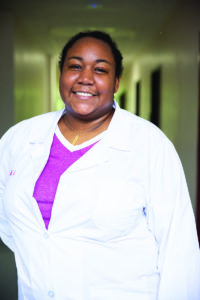 Many surgical procedures now employ laparoscopes, which are narrow fiber-optic instruments that allow medical personnel to see inside their patients without the need for a large incision.
Many surgical procedures now employ laparoscopes, which are narrow fiber-optic instruments that allow medical personnel to see inside their patients without the need for a large incision.
Such laparoscopic operations, using minimally invasive techniques, result in less intrusive incisions, helping improve recovery times and overall patient outcomes. However, doctors can work only on what they see, so keeping the view from the laparoscopes clear is a key part of the process.
That’s where UTSI student Anna Bull and her research come into play.
A second-year graduate student in UTSI’s Biomedical Engineering and Materials Science research group under the direction of Professor Jacqueline Johnson, Bull is working on techniques to produce antifogging coatings for laparoscopic devices.
“We used pulsed laser deposition on glass to produce what are called diamond-like carbon thin films,” said Bull. “These particular films should drastically help improve antifogging results on laparoscopic equipment, which helps improve the experience for patients and medical staff alike.”
As a testament to the importance of the research, the National Institute of Biomedical Imaging and Bioengineering, part of the National Institutes of Health, is supporting it through a grant.
“This work will give a clearer picture to surgical teams, reducing potential contamination of the lens in addition to antifogging,” said Johnson. “Furthermore, a successful coating could be used across various other medical equipment and procedures as well.”
Bull said that UTSI, in particular, offers a major advantage over many if not most other graduate school experiences in that its students don’t have to teach courses and can instead focus on their research.
She also noted that the ratio of faculty members to students is such that UTSI’s grad students feel well supported, and that supervising researchers are always willing and available to help. Recalling her first experiences at UTSI, Bull talked about how students who were already established at the institute reached out and showed her around the campus and Tullahoma, and how different research groups feel connected to each other.
“I really like it here,” said Bull. “I spent the first part of my time here training, getting used to the lab space, making progress with some early work. Now I’m really getting into it and enjoy what I do and what we do as a team.”
The work could pay off for countless future patients whose medical experiences may be improved by Bull’s research.